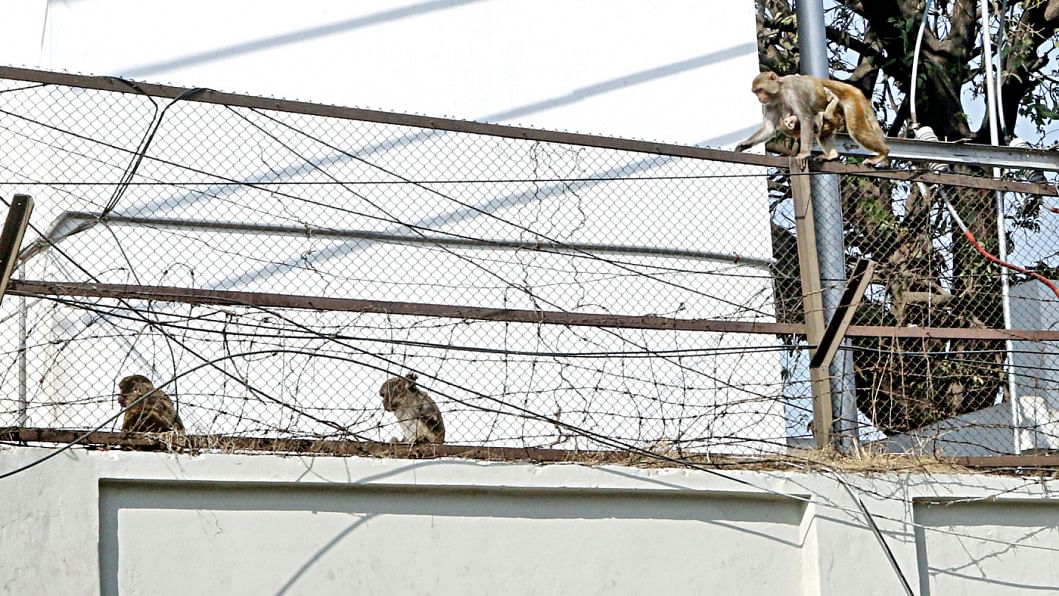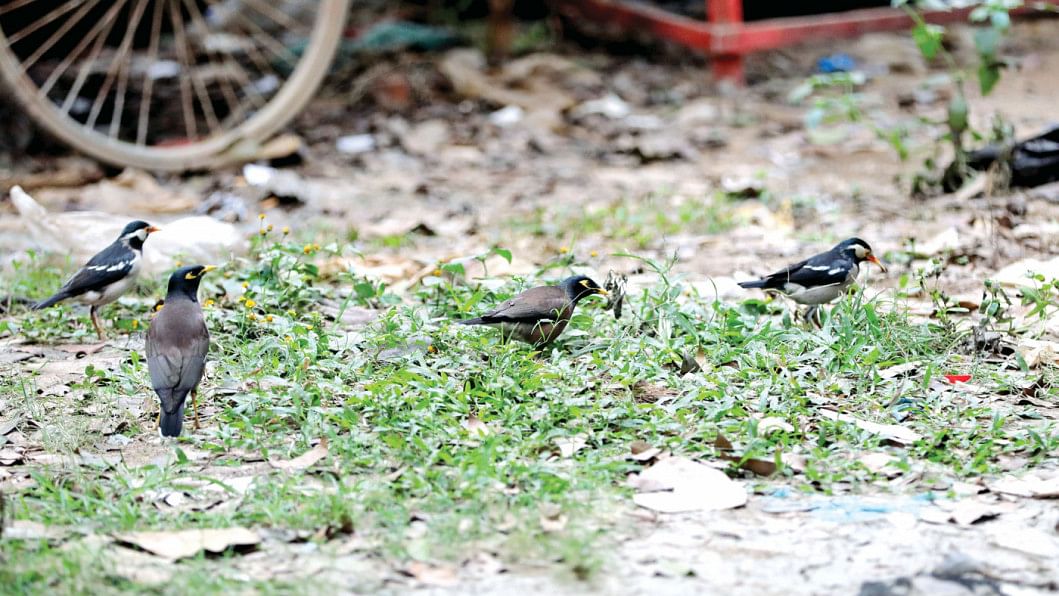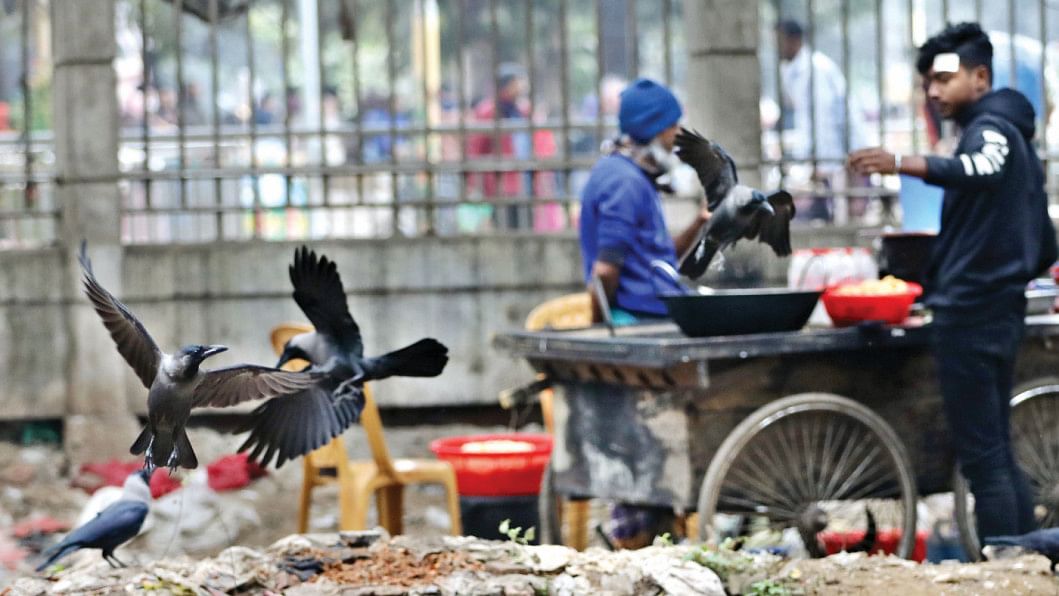Dhaka’s vanishing wildlife
Gendaria, a neighbourhood in Old Dhaka, once known for its spacious roads and European style colonial buildings, has lost much of its grandeur. In the last 50 years, the old bungalows and gardens have been replaced with high-rise buildings and the neighbourhood is now like any other congested, crammed parts of the old town.
However, even after the spate of modernisation and "infrastructural development", the residents of Gendaria used to preserve a heritage of their own. For hundreds of years locals have been feeding and caring for troops of free ranging rhesus macaques that considered Gendaria to be their home.
Children feeding and playing with the baby monkeys; homemakers throwing leftover food to an eagerly waiting troop, vegetable and fruit peddlers trying to protect their goods from some stealthy and cunning macaques -- but without hurting them -- were some of the familiar pictures of Gendaria even a decade ago. However, the number of rhesus macaques in Gendaria has dropped drastically.
According to 70-year-old Md Afzal Sheikh, a resident of Gendaria, "Monkeys have been living in this part of Dhaka for hundreds of years. We have seen in our youth that most houses in Gendaria used to have a small garden where the landlords used to grow fruits and vegetables which attracted these monkeys."
"Residents like us used to treat them well. Particularly, some of our Hindu neighbours, who were quite a majority in this part, used to revere them," he said.

According to Afzal, in the last 20 years, Gendaria went through radical changes. Many old families have left this area and sold their property to real estate companies who have built massive high-rise structures. As a result, macaques have also lost their sources of food and shelter.
One of the last remaining shelters of these monkeys in Gendaria is the factory of Sadhana Aushadhalaya, a manufacturer of Ayurvedic medicines. In 1914, when the factory was established, its founder, physician Jogesh Chandra Ghosh arranged some spaces and food for the monkeys of Gendaria.
Respecting Ghosh's legacy, employees of Sadhana are still feeding and sheltering a few of the last remaining monkeys.
Dipak Kumar, an employee of the factory, said, "Even 5-10 years ago, these monkeys used to roam freely in the neighbourhood; unfortunately, they are not safe anymore. Children nowadays throw stones and bricks at them, which was unheard of even a decade ago. So, we try to keep them confined to our premises."
"Also, people have become very poor recently. The shop owners, households cannot afford to spare food for these animals. Respecting our founder's legacy, we still feed them at least 5-6 kilos of grams daily," he added.
Besides the macaques of Gendaria, Dhaka, despite its concrete jungles, used to be a home to quite a number of wild animals, many of which nowadays can rarely be seen due to loss of habitat and sources of food.
Although their presence is hardly missed by the busy Dhakaites, the urban ecosystem is getting affected. Due to the absence of these city dwelling wildlife, plants fail to breed while harmful insects and pests may increase alarmingly, said experts.
For instance, one of Dhaka's once abundant but rarely seen and never adored wildlife was different types of frogs. Spots of vegetation such as bushes and shrubs used to be their habitat and their tadpoles used to be seen in all types of clogged waters.
Studies have proven that frogs and their tadpoles are some of the most efficient biological controllers of mosquitoes. The tadpoles, especially, consume huge amounts of eggs and larvae of mosquitoes while the adult ones consume the flying insects.
According to Dr Manirul H Khan, professor, department of zoology, Jahangirnagar University, "Tadpoles especially consume eggs of Aedes Aegypti mosquitoes which are the carriers of dengue and Chikungunya viruses. Some fish also consume the eggs and mosquito larvae but the tadpoles can stay and hunt in water bodies which are inaccessible to fish."
"The number of frogs has declined due to severe pollution of waters caused by factories discharging industrial waste and excessive use of pesticides in the farmlands," added Dr Khan.
In March 2021, Dhaka south and north city corporations released tadpoles in the water bodies to control the number of mosquito larvae.
Another of Dhaka's hardly seen but beneficial inhabitants is the mongoose. Asian grey mongooses live in burrows in bushes and thickets near human settlements.
Once, mongooses used to be kept as pets in many low-lying parts of the city to keep acheck on rat and snake populations.
In Sutrapur, lives several families of snake charmers. They still maintain this tradition of petting these highly agile and cunning predators.

Shopon Paik, one such snake charmer, said, "I have heard from my grandfather that households throughout Old Dhaka used to treat mongooses well as they kill snakes and feed on mice. My grandfather used to sell mongooses to many households who kept them as pets."
"Still, we use these animals to detect snake pits. With their acute sense of smell, they can detect the existence of snakes from a long distance," he added.
Although mongooses can thrive near cities, according to Shopon, these beneficial mammals are also declining in Dhaka.
"The entire city is now covered in bricks and cement. Green spaces where these animals can dig burrows and raise their pups are declining fast. Some still live in unused sewerage lines but they die when excess rain water clog these lines," he added.
As the city's ground dwelling animals are facing threats, many of the winged residents have also become extremely vulnerable.
Ornithologist Enam Ul Haque said, "Even two decades ago, Dhaka was studded with a lot of greenery where many exotic bird species could be found."
However, due to rapid destruction of their habitats some of these birds have been wiped out entirely from the city. For instance, the house swift was one of the most common bird species in the city.
Haque said even 20 years ago, hundreds of thousands of house swifts could be seen catching flying insects, including mosquitoes, all over the city. Nowadays, this bird is almost nowhere to be seen in the city.
"This bird used to feed on flying insects that live in grassy fields. In the last two decades or so, grassy fields in Dhaka have completely vanished. Also, these birds used to nest on wooden beams of old styled buildings, which have also become extremely rare in the city," shared Haque.
He said even a decade ago, house swifts could be seen in Kurmitola and areas adjacent to the airport but not anymore. "You may find a few of them if you are extremely lucky," said Haque.
Again, Dhaka, a city surrounded by rivers and once studded with countless number of water bodies, was the home of various types of aquatic birds. Cormorants, fish eagles, waterhen, varieties of kingfishers and different types of migratory aquatic birds were abundant in the city.
As the rivers became increasingly polluted, the banks have been encroached upon by grabbers and water bodies have been filled up to make space for housing projects, these aquatic birds have lost their food and shelter.
"The waters of Buriganga, Turag and Balu rivers have become so polluted with industrial waste that no fish or aquatic insects can survive there. You can visit these rivers around Dhaka and you will not find a single aquatic bird because they cannot find food in these waters," said Haque.
Floodplains like Purbachal used to be a resourceful habitat for birds and wildlife. Urbanisation without consideration for their habitat has drastically reduced their numbers.
"Herons, egrets and cranes were abundant in this floodplain, but are now nowhere to be seen. Even three years ago, I watched more than 2,000 lapin, a migratory bird which comes here from China every winter. At present, I found only around 200 of them. In the years to come, their number will definitely decrease further with increasing man-made activities in those parts," he added.
Experts have called for careful urban planning and conserving natural habitats within the city to preserve the existing species and recover the lost ones.
Rakibul Haque Amil, an architect by profession and chairperson of People for Animal Welfare Foundation, said, "When we planned our city, we did not actually think about the wildlife that live in and around the city. Even our green spaces are not quite suitable for their living."
"If you think about the intensity of LED lights, dust and noise pollution around the parks, you can easily assume how difficult it is for the birds and other species who live nearby. These animals wake up, forage and return to their nests or burrows in accordance with the sunlight. Now if you keep the entire city illuminated with LED lights and noisy with unrestricted sounds everywhere, how will they survive?" he asked.

"Besides, our city dwellers are not at all concerned by the animals who live around them. When they construct a building or any type of structure, they do not care at all about their habitat," added Amil.
Prof Manirul suggested increasing green spaces in Dhaka. "We need to increase the amount of grassland and vegetation in the city. Most parts of our city have been paved with concrete surfaces which increase dust, heat and reduce habitat for wildlife."
Meanwhile, ornithologist Haque recommended preserving green space as natural ecosystems.
He said, "In the cities of developed countries, wild spots are deliberately left within and around the city to preserve the natural habitat. These wild spots are not just artificial parks. These are spaces that are preserved intact when the city was not built there."
"The difference between parks and wild spots is that only selected species find food and shelter in the manmade parks, whereas wild spots are an absolutely natural ecosystem where varieties of species thrive naturally. We still have the opportunity to preserve such wild spots in Purbachal, Narayanganj, Basila and the areas towards Dhaka," he added.
Md Shahnawaz Khan Chandan is an Assistant Professor at Institute of Education and Research, Jagannath University. The writer can be reached at [email protected].

 For all latest news, follow The Daily Star's Google News channel.
For all latest news, follow The Daily Star's Google News channel. 



Comments